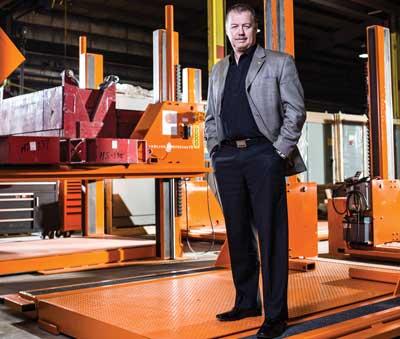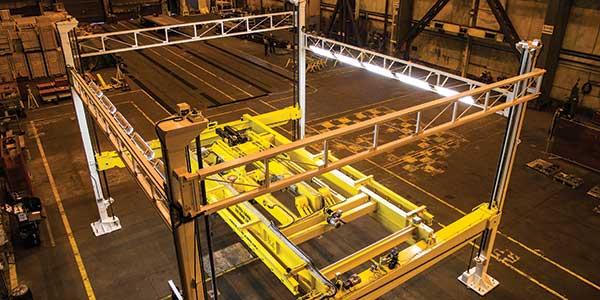- FMA
- The Fabricator
- FABTECH
- Canadian Metalworking
Building BIG Things...to Build BIG Things
Ontario equipment builder uses strong diversification plan to thrive, even in rocky financial times
- By Joe Thompson
- February 1, 2014
- Article
- Made In Canada

Tom Beach, president, who has been with the company for more than 30 years, has helped lead the diversification of the company into new industries. Future expansion into the oil and gas and marine sectors will only keep this equipment builder on top. Photos by Jon Evans Photography.
If you are one of the millions of people who have seen the epic stage show “O” by theatrical troupe Cirque du Soleil, you have also seen a machine built by Handling Specialty at work.
In fact, this Grimsby, Ont., equipment builder was even recognized by Guinness World Records for the project—the world’s largest underwater hydraulic lift system.
The structure in question comprises four hydraulically powered lifts that raise and lower the show’s main stage. Simple enough until you learn that the stage is inside a 1.76-million- gallon pool. Lifting 1 million lbs. may seem like a daunting task, but the creation of large, complex equipment for high-profile customers is the norm at Handling Specialty.
“When we look for new customers, we first look at the industry we want to serve, and then identify the major players within that sector that may be a good fit for us as a partner,” explained President Tom Beach.
And by serving a diverse customer base from among many sectors, the company minimizes the fluctuations that can occur during the downward trend of a business cycle. In the past as much as 90 percent of the company’s business was in the automotive sector. Today, Beach said, that number is closer to 10 percent, after forays into entertainment, aerospace, transportation, and energy.
Recent unique projects include a four-story, multiaxis airplane painting system for aerospace; wing assembly platforms for the F-35 Joint Strike Fighter; lifts for a jet engine test platform; and underwater stage systems for Royal Caribbean’s cruise liners Oasis of the Seas® and Allure of the Seas®.
“We like to form tight, long-term associations with our customers because most of the work we do is so specialized. It can take months of design and engineering work before we even start a build, so it’s important that we create great relationships,” said Beach. “For the Cirque du Soleil project, for example, we had staff living in Las Vegas for weeks during the installation to make sure everything went as smoothly as possible. That one project alone was enormous, stressful, and chaotic, but everyone who worked on it is proud of what we accomplished.”
Since 1963 Handling Specialty has dedicated itself to designing and building lifting systems that are often one of a kind. Creating one-of-a-kind pieces of equipment can be challenging, but it is a process that the company has been perfecting for 50 years.
Many milestones have passed since the early days of the company, and in 2011 the company made another transition, becoming a member of the Whiting family of companies and assuming Whiting Equipment Canada’s rail equipment business.
The Beginning
At the beginning, Handling Specialty founder George Machan ran the company from a two-car garage in Toronto and served only the local area. The business at this time manufactured floor cranes for lifting automobile engines, and it sold Joyce screw jacks and Southworth minilifts and cam lifts.

An example of one of the company’s large, custom machines this cradle system designed to lift jet engines, is ready for testing at Handling Specialty’s Hamilton, Ont., facility. The company opened this second location in 2012 to handle its very large projects.
A decade later Machan formed a partnership with HiRoss Denco of Italy to handle its sales and manufacturing operations in North America and built a new facility in Mississauga, Ont. In 1979 the company moved to its current Niagara-region location.
Following the move, Handling Specialty began a strategic transition away from manufacturing and selling standard equipment to engineeredto- order equipment, an approach that continues today, explained Beach, who has been with the company for more than 30 years.
“Each build is different, with its own set of challenges that need to be overcome. That’s why we put so much emphasis on our people-stock,” said Beach. “We look for people that can thrive in our environment, which can be hectic and chaotic at times. We also look for people that have held senior positions at big corporations who understand the atmosphere at the automotive assemblers and their tiered suppliers, for example.”
People-stock is a term that Beach says often, using it to call attention to each key member of the team, from the sales office to the shop floor.
“Our departments need to work together, and they understand that,” said Beach. “There is no interdepartmental name-calling here. Whether it’s sales or manufacturing or quality, each department knows they can’t be successful on their own.”
Each project starts in the same manner: with a meeting of the minds. Design, engineering, and manufacturing department heads all sit around the same boardroom table to discuss how the build will proceed. Design for manufacturability is an important concept when you are building something that has never been built before.
Building Big Things
In 2012 the company opened a second manufacturing location in Hamilton, Ont., to handle the really big projects—equipment builds that just wouldn’t fit into its existing manufacturing footprint.
Overhead cranes move parts weighing thousands of pounds to the welding bays, where the company’s CWB-certified welders begin the process of building and assembling the equipment. The company recently invested in new welding technology to enable its welders to create better beads in a more productive manner.
On the shop floor, parts that have come in from customers and suppliers are assembled and tested inhouse before the machine gets torn down and shipped. Workers build powertrains, control panels, and structural components, and each project has its own team.
“Each build has its own team of millwrights, assemblers, and welders that take the project from cradle to grave,” explained Beach. “We want our staff to know what they are working on and take pride in what they are creating. Giving them a sense of ownership of the project helps not just with productivity, but also with quality control.”

(l to r) Lead Hand and Weld Inspector Chris Negus, Lead Hand and Millwright Jerry Sloat, and Millwright Pane Momich test custom lifting devices before shipping at the company’s Grimsby, Ont., location.
All assembly work at Handling Specialty is done through kitting.
Kitting means that all parts needed for the manufacture of the machine are gathered at one location. This helps to ensure that Handling Specialty’s assembly team has all of the necessary components before a build can begin.
This manufacturing method helps to keep the build moving forward without the interruptions caused by a search for missing pieces. This makes part labeling important.
On the shop floor, an example of one of the company’s large machines, a hydraulic cradle system designed to lift jet engines, is getting ready to ship after final assembly and testing.
“The customer for this machine wanted a safety system in place in case of failure,” explained Beach. “Our engineering team came up with a cable system that will support the entire weight of the engine in the unlikely event of a failure. Once they came up with the idea, it was up to our build team to put it together. That’s just one of the many examples of our staff working together to get the client the results they need.”
Diversification Plan
Handling Specialty has a customer base that essentially is a who’s who of the automotive assembly and aerospace sectors. More recently the company has been producing equipment for the transportation sector, including a system for lifting a railcar body for the maintenance or replacement of a bogie.
The energy sector—including nuclear power and oil and gas—is another growth area for the company, as is the marine sector.
“I’d love for us to build a machine that can lift an entire vessel,” said Beach. “With the work currently scheduled on the east coast at Irving, as well as locations in Quebec and on the west coast, we think that this market is ready to boom. And we want to be a part of that.”
A few years ago the company had 39 employees; today that number is nearly 80. In a region that is better known on the world stage for producing wine than producing machines, Handling Specialty is creating a name for itself.
“We like to say that we build big things to help our customers build big things,” said Beach. “Recently that’s become our corporate statement. We feel that we are ready for any challenge that our clients throw at us. We even like projects that are high risk … it makes the successes all the better.”
subscribe now


Keep up to date with the latest news, events, and technology for all things metal from our pair of monthly magazines written specifically for Canadian manufacturers!
Start Your Free Subscription- Trending Articles
- Industry Events
MME Winnipeg
- April 30, 2024
- Winnipeg, ON Canada
CTMA Economic Uncertainty: Helping You Navigate Windsor Seminar
- April 30, 2024
- Windsor, ON Canada
CTMA Economic Uncertainty: Helping You Navigate Kitchener Seminar
- May 2, 2024
- Kitchener, ON Canada
Automate 2024
- May 6 - 9, 2024
- Chicago, IL
ANCA Open House
- May 7 - 8, 2024
- Wixom, MI














